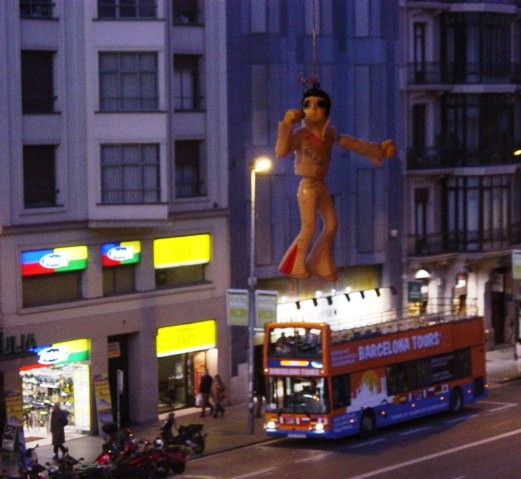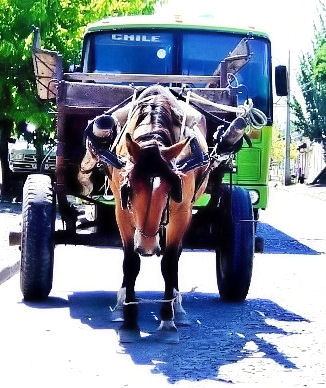The rhythmic chanting issued forth from a nearby speaker and settled down on our conversation, providing the somber atmosphere that the occasion deserved. The discussion, as we sat on a friend’s porch in a tiny village in the Pampanga Province of the Philippines that Maundy Thursday, centered around the crucifixions and self-flagellants that we had come to see.
The chanting, known as The Passion because it is the reading of the betrayal, trial and death of Jesus, begins at 12 a.m. the Monday of Holy Week and continues twenty-four hours a day until concluding at midnight on Good Friday. The melodious tune is distributed throughout the villages of Pampanga via systems of speakers ensuring that everyone can hear the continuous serenade.
The real highlight of Holy Week in Pampanga is not the solemn chanting of the Passion, but rather the Good Friday bloodlettings. Beginning at noon, several fanatical Catholics are nailed to crosses in a ceremony to reenact the crucifixion of Jesus. This traditional ceremony, which began in the Philippines in the late 1940’s, is preceded by a procession of young men flagellating themselves as they walk the Via Cruces (way of the crosses) to the Filipino Golgotha in San Pedro Cutud, which is where the most famous crucifixion ceremonies take place. The participants in these fanatical rituals usually participate because of a pact that they have made with God to heal a sick relative, to help them overcome an illness or some similar request for help that they believe was granted.
The Good Friday activities were briefly overshadowed in our conversation by a debate over the ever-present white noise. My friend insisted that the Passion was coming from a tape or CD. His girlfriend, on whose porch we were seated, insisted that local residents were actually nearby chanting into a microphone. The boyfriend doubted her assertion and wondered aloud how the vigil could be kept up, non-stop, for 120 hours. She didn’t like to have her integrity so openly questioned and, within minutes, had arranged a tour of the Passion facility for us.
On the way to see what I expected to be a deeply religious ceremony, images of devout priests or nuns solemnly chanting the Passion in a secluded room of a great cathedral swirled around in my head. The scene had just crystallized in my imagination when the car came to a halt in an unpaved alleyway. We disembarked from the car and walked about twenty meters to the home of the Passion. It was located just past two groups of men hunched over a local gambling game.
The soaring cathedral of my imagination was replaced by the reality of a diminutive structure with a tin roof supported by narrow pieces of wood and walls made of random pieces of plastic tied together. There didn’t appear to be much extra plastic in the neighborhood because only about one-fourth of the area normally reserved for walls was covered.
Ducking under a long piece of transparent cotton cloth that served as the doorway, we entered the building and silently covered the three meters between the door and the room in which the Passion was being read.
The reading room was defined by the trunks of four palm trees in an X shape on either side of a space at the rear of the building. At the ends of the Xs were two tree trunks dug into the ground and extending to the tin roof. Additional trunks were placed on top of both Xs and palm leaves were hung from these X toppers. The reading room floor, like the floor of the rest of the building, was dirt. Another transparent cotton cloth functioned as the door to the Passion reading room. In the room were two middle-aged women seated on folding chairs and reading the Passion from an ornately scripted book.
Upon seeing us enter, one of the Passion callers extended a microphone to my friend and asked him if he would like to ‘sing.’ My friend replied with a look of astonishment, which she misunderstood to mean that he didn’t hear the offer. To ensure that he could hear the second time, she spoke it into the microphone. Now the entire village heard the offer. The offer was refused and soon repeated, into the microphone, for me. I suppressed a smile and politely refused the offer.
All of my romantic notions about the Passion had been shattered faster than money was changing hands with the nearby gamblers. I felt as if I had just found the Wizard of Pampanga, but she and her friend were seated behind a transparent cloth in an unpaved alley rather than hiding behind a great curtain at the end of a yellow brick road.
Any lingering expectations I harbored of a solemn Good Friday were dashed long before we arrived in San Pedro Cutud the following day. The road to San Pedro Cutud was lined with vendors and people gawking at the passing flagellants who had chosen to pay their penitence in their own villages rather than at the Via Cruces.
The atmosphere was more festive than somber and the majority of the people seemed to be less interested in looking at the flagellants than they were in gaping at my friend and me. It was strange to think that the sight of two white men in the back of a Jeep was rarer for those spectators than the spectacle of young men wearing hoods, wreaths and whipping their own backs with bamboo reeds in order to aggravate previously-inflicted wounds in hopes of drawing out as much blood as possible.
The real festival was, however, in San Pedro Cutud. The three-kilometer stretch of scorching hot pavement known as the Via Cruces is where the majority of the flagellants practice their craft. For that reason, it was teeming with vendors, tourists and local gapers. Many younger fans of the flagellants, and those intent on getting a good photograph, weren’t content with merely watching from the roadside. These eager aficionados followed close behind the penitents, getting splattered with blood, as they reveled in the atmosphere and snapped pictures.
The last of the back-beaters arrived at “Golgotha” shortly before noon, and shortly before those who were to be mock crucified. By that time, Golgotha was awash with vendors and thousands of spectators eagerly awaiting the crucifixion ceremony.
To make a path through the throngs of onlookers for those about to be crucified, men on horseback and dressed in Roman Centurion costumes rode their horses recklessly through the crowd causing people to flee for their safety. I didn’t witness anyone get trampled by a horse or a retreating spectator but, with the chaos that was caused by the introduction of the centurions, it seems improbable that it didn’t happen.
When all of the participants in the crucifixion ceremony were on Golgotha, the crowd began to surge forward in hopes of getting a good view, and being part of a photograph. Each time someone on the hill turned a camera towards the crowd, the people would clamor for a spot in the photograph the way fans do at a sporting event. How they could see the photographers, though, baffled me because I was having difficulty seeing anything through the umbrellas that more than 50 percent of the crowd had brought to protect themselves from the searing summer heat.
The parasols didn’t impair my vision for long. I had a well-connected tour guide and was soon on Golgotha itself, rubbing shoulders with the to-be-crucified, dozens of photographers, several cameramen and a swarm of small children. Each person on the hill was jostling for a close-up view of those about to receive nails in their hands or those recently erected into the crucified position.
The crucifixion process itself began when the participant had finished praying and lay upon one of the three crosses available. Next, their arms and waist were bound tightly with rope and nails were doused in rubbing alcohol. The proper placement of the nails in the palms and the feet was then agreed by the to-be-crucified and the nailer.
After the agreement was reached, the palms were also doused in rubbing alcohol. The surge then began amongst the crowd as they jockeyed for the best view of the impending nailing of the hand. Two swift, compact and precise swings of the hammer were all that was needed before a nail had passed through the palm of each hand and had penetrated the cross.
As soon as the nails had been placed in the palms, a group of official crucifiers gathered behind the supine cross to push it upward such that it swung on the metal hinge at the base until it was standing upright. Once upright, the crucified person’s feet, and two more nails, were smothered with rubbing alcohol. Two more swings of the hammer and the nails had been driven through the feet and into the small platform on which the now fully crucified person was standing.
The amount of time a person remained crucified was determined by that person’s pain tolerance. Most stayed on the cross for a few minutes, while some barely had the nails in their feet before they were begging to be taken down.
The nails were removed the moment the cross returned to a horizontal position. The wounds were then sprayed clean with rubbing alcohol and covered with cotton balls. Ironically, many of the participants got down from the cross and walked barefoot through the dirt while the alcohol was still fresh in the nail holes. The desire to keep his wounds clean could explain why one of the participants was carried away, but I suspect that it may have had more to do with pain.
The majority of the crowd dispersed after only a few crucifixions had taken place. Thirteen people were crucified that day, but the majority of the crowd saw only a few. We joined the quick retreating crowd and were back on the porch long before the last person had been hung on the cross.
After changing out of our blood splattered clothes, we discussed the final highlight of the Pampangan Holy Week, the blowing up of a Judas Iscariot doll in the church parking lot after Easter Services are complete.
The solemn hymn of the Passion still penetrated the air, but the religious fervor that I had associated with it, and the entire Lenten Rites festival just twelve hours earlier, had gone. It all seemed like one big show. It was, at least, an entertaining show.


2 comments On Passion and Pain, Holy Week in the Philippines
daktilogibigibi.2kmZEhQisTSY
Usually I don’t read article on blogs, however I would like to say that this write-up very forced me to take a look at and do so! Your writing style has been surprised me. Thanks, quite nice article.